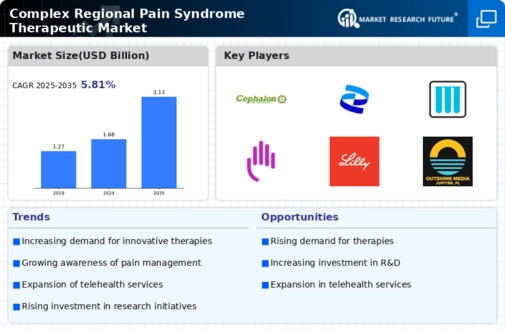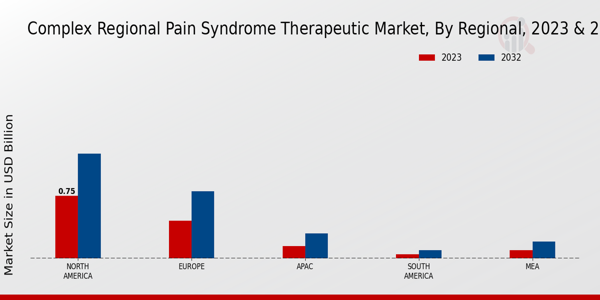Market Growth Projections
The Global Complex Regional Pain Syndrome Therapeutic Market Industry is projected to experience substantial growth, with estimates indicating a rise from 1.68 USD Billion in 2024 to 3.13 USD Billion by 2035. This growth trajectory reflects a compound annual growth rate (CAGR) of 5.83% from 2025 to 2035, driven by various factors such as increasing prevalence, advancements in treatment modalities, and growing investment in research. The market's expansion is indicative of the ongoing efforts to improve therapeutic options for individuals suffering from CRPS, highlighting the importance of continued innovation and support in this field.
Increasing Prevalence of CRPS
The rising incidence of Complex Regional Pain Syndrome (CRPS) is a primary driver for the Global Complex Regional Pain Syndrome Therapeutic Market Industry. As awareness of the condition grows, healthcare providers are identifying more cases, contributing to an estimated market value of 1.68 USD Billion in 2024. This increase in diagnosed cases necessitates the development of effective therapeutic options, thereby propelling market growth. The condition, often resulting from trauma or surgery, affects a significant number of individuals, particularly in the middle-aged demographic, highlighting the urgent need for targeted treatments.
Advancements in Treatment Modalities
Innovations in treatment approaches for Complex Regional Pain Syndrome are significantly influencing the Global Complex Regional Pain Syndrome Therapeutic Market Industry. Emerging therapies, including neuromodulation techniques and advanced pharmacological options, are enhancing patient outcomes. For instance, the introduction of personalized medicine strategies is enabling tailored treatment plans that address individual patient needs. This trend is likely to expand the market, as evidenced by the projected growth to 3.13 USD Billion by 2035. The continuous evolution of treatment modalities reflects a commitment to improving quality of life for those affected by CRPS.
Rising Awareness and Education Initiatives
Enhanced awareness and educational initiatives regarding Complex Regional Pain Syndrome are pivotal in shaping the Global Complex Regional Pain Syndrome Therapeutic Market Industry. Campaigns aimed at both healthcare professionals and the general public are crucial for early diagnosis and treatment. As awareness increases, more patients seek medical attention, leading to higher demand for therapeutic interventions. This trend is likely to contribute to the market's growth trajectory, as stakeholders recognize the importance of timely intervention in managing CRPS effectively. The focus on education may also lead to improved patient outcomes and satisfaction.
Regulatory Support for Innovative Therapies
Regulatory bodies are increasingly supporting the development of innovative therapies for Complex Regional Pain Syndrome, which is a significant driver for the Global Complex Regional Pain Syndrome Therapeutic Market Industry. Streamlined approval processes for new treatments and incentives for research and development are encouraging pharmaceutical companies to invest in CRPS therapies. This regulatory environment fosters innovation and expedites the availability of new treatment options to patients. As a result, the market is poised for growth, with a focus on delivering effective solutions that address the unique challenges posed by CRPS.
Growing Investment in Pain Management Research
The increasing investment in pain management research is a crucial factor driving the Global Complex Regional Pain Syndrome Therapeutic Market Industry. Governments and private organizations are allocating substantial funds to explore new therapeutic avenues for chronic pain conditions, including CRPS. This focus on research is expected to yield novel treatment options and improve existing therapies, fostering market expansion. The anticipated compound annual growth rate (CAGR) of 5.83% from 2025 to 2035 underscores the potential for growth in this sector, as innovative solutions emerge to address the complexities of CRPS.














